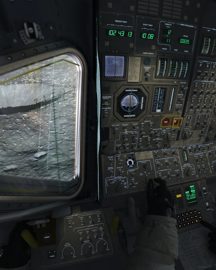

(click image for high resolution)
Computer reconstruction of Neil Armstrong’s view out the Lunar Module on Apollo 11, 520 feet above the lunar surface just as he transferred from automatic control to semi-manual “attitude hold ” (note his hand reaching for the switch), to fly the vehicle past West crater (visible out the window) to a smooth area for landing. Note the landing point designator, the graded angles on the window that would guide Armstrong’s eye to the computers estimate of a landing spot, and the 1202 program alarm indications on the guidance computer display at lower right.
The image was created according to the author’s conception by digital artist John Knoll, with research input from Paul Fjeld. A small number of compromises were made in order to create the image: the viewpoint is actually about 18 inches behind where Armstrong’s would have been; the view of West Crater is a few seconds out of sync with the mission timer and the events depicted inside the LM; the 1202 alarm, the last of them, occurred approximately 15 seconds earlier so it would most likely have been cleared from the display by this point; some of the checklists that the crew had arrayed around them may be missing; boulders around the crater are included from Armstrong’s description.
The LM interior was modeled in AutoDesSys FormZ and LuxologyModo from a variety of reference sources, including NASA drawings, historical photographs, and photographs of the LM simulator at the Cradle of Aviation Museum in Long Island. The lunar surface was modeled in Luxology Modo using lunar orbiter photographs and the Apollo 11 powered descent film as reference. Textures were created in Adobe Photoshop. Final rendering was done in LuxologyModo.